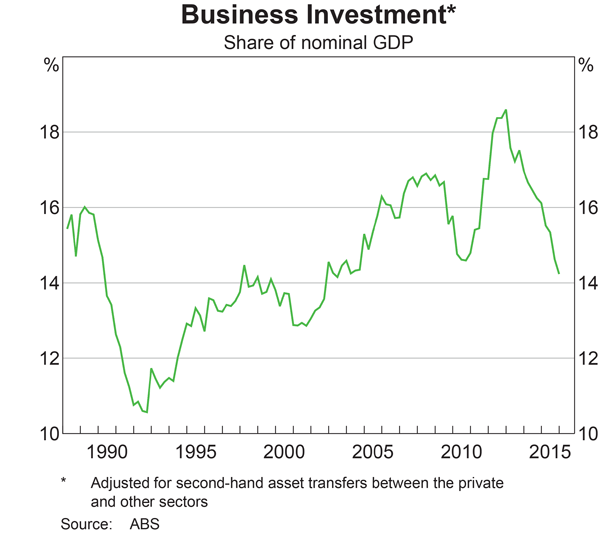A lot of noise has been made about the ‘Transition’ of the Australian economy in the past year. There is no doubt that our remarkable performance during and after the GFC was due in no small part to the mining boom.
High commodity prices drove a large number of iron ore, gas and base metals expansions that transformed the economies of Queensland and Western Australia. Hi-Vis clad FIFO workers earning huge salaries became part of the landscape.
The dramatic fall in commodity prices has been almost as spectacular as the rise. Companies banking on sustained high prices have suddenly seen the rug pulled out from under them.
We can see the effect this has had on business investment:

Has the Economy ‘Transitioned’?
Economic growth has remained stable, which is remarkable considering the huge chunk of money that has been ripped out of the economy. Commentators suggest that the economy has ‘transitioned’ from a mining economy (where we sell ‘stuff’ like iron ore and coal) to a service economy, where income and jobs come from the service sectors (think retail, food & beverage, banking, education etc).
But I ask the following questions:
- Have we really transitioned?
- How can you remove such a large amount of capital and spending and not see a negative impact?
- If we have transitioned, how many service jobs does it take to replace the salary of one FIFO worker?
A recent article caught my eye that shows we really haven’t made a successful transition thus far. Jason Murphy is an economist who writes for news.com.au (see his article here) and makes some sobering observations:
“What you wouldn’t know if you only followed the unemployment rate is that hours worked in the labour market have had a massive tumble.”
The section marked in red is a fall that started in January this year and hasn’t stopped
While hours worked does sometimes fall, the red section in the graph above is the biggest since the GFC, The final nail in the coffin is wages. They are in a bad way and Wages growth is the lowest it has been in years.
So, rather than an economy successfully making a transition, we see a huge reduction in the number of hours worked and the lowest wages growth in decades.
I am sceptical that our economy can undertake such a huge transition without some flow-on effects. Imagine a FIFO worker (used to high wages, subsidised accomodation, food and transport) now coming to terms with traditional service sector wages and conditions. Never mind the billions of dollars of capital investment no longer taking place in our regional centres.
For me, these are signs that things are not going well in the Australian economy, and should influence how you think about your investment portfolio.
If you’d like to know more about how we can help you, simply contact our office to arrange a complimentary initial consultation on 07 5494 0650.
